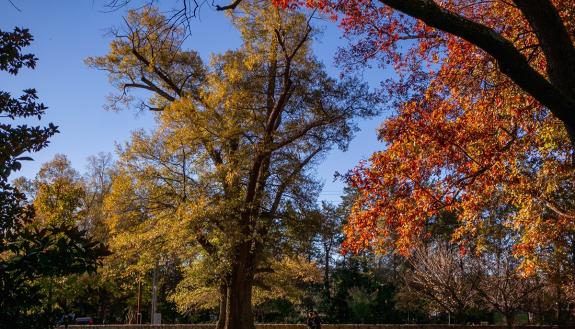Duke’s Oldest Trees: Witnesses to a Century of History
Long-lived oaks, magnolias and cedars offer tangible connection to Duke’s beginnings
As Duke celebrates its centennial year, Conner’s goal is to help these oaks, and the other trees planted around the late 1920s and early 1930s when West Campus was built, see as much of Duke’s second century as possible.
In a busy campus setting, keeping the roughly 90-year old trees healthy is a steep challenge. The trees are carefully monitored for signs of rot and disease and limbs in danger of falling are trimmed. In recent years, a small number of ailing oaks have been taken down and replaced on Abele Quad.
“These are trees that, in nature, typically live about 150 years,” Conner said. “But we’ve got them in an urban environment where there’s a lot of foot traffic, people driving near them, compacting the soil. It’s just not the environment they’re used to.”

While the original oaks on Abele Quad are nearing the end of their lifespans, they are far from the only trees that serve as living links to Duke’s beginnings.
Duke has more than 16,000 inventoried trees on its campus and thousands more in campus woodlands on and in the more than 7,000 acres of Duke Forest. As we mark National Arbor Day, which is Friday, April 26, take a moment to learn about trees on both East and West Campus with compelling histories of their own.
East Campus Grove

Duke University Landscape Architect Mark Hough isn’t sure exactly when the willow oaks and ash trees that dot the rolling lawns of East Campus, sometimes called the East Campus Grove, were originally planted.
Their appearance in a 1928 aerial photo leads Hough to believe they may have been part of a landscape overhaul of then-Trinity College sponsored by James B. Duke roughly a decade earlier.
The exact age of the trees that shade the grassy expanses in front of the East and West Duke Buildings is debatable, but their appeal is timeless.
“They are the character generator of East Campus,” Hough said. “You have this quintessential park-like canopy of trees. It’s such a simple and beautiful aesthetic that people just understand and love and feel comfortable in.”
Duke Chapel Cedars

Rising above the walkways and shrubs in the space between Duke University Chapel and the Bryan Center, a handful of red cedar trees provide an evergreen buffer between West Campus’ most sacred space and its most bustling one.
While many of the trees in Duke’s core were planted shortly after the buildings and quads of West Campus were constructed, these cedars predate everything that surrounds them.
During a visit roughly a decade ago to the Frederick Law Olmsted National Historic Site to view the plans the Olmsted Brothers landscape firm used to design West Campus, Hough found plans from the late 1920s for the landscape around Duke Chapel.
“Remove pines. Leave cedars,” read the instructions on the plans.

“It hints to the kind of ethic the university has in regard to trees,” Hough said about the directive to preserve the cedars. “Our emphasis on trees is not a 21st century thing that we just made up and think is important. It’s been embedded in our campus since the beginning.”
Cameron Woods

Duke Facilities Management maintains a database of more than 16,000 campus trees containing information about their size, health and species. Duke’s true tree population is much higher since the database doesn’t count trees found in the patches of forest that dot campus.
Tucked between Cameron Indoor Stadium and the Sanford School of Public Policy, Cameron Woods is one of Duke’s most well-known pockets of woodland. Largely untouched by Duke’s Landscape Services team, the small forest offers a glimpse of what the landscape looked like before West Campus was built.
On the edge of the forest near the Card Gym parking lot, there’s an oak tree that, based on trunk measurements, is estimated to be roughly 350 years old.
“Having these parcels of woods completely changes how you feel when you move through campus,” Hough said. “We’re lucky to have them. A lot of campuses don’t.”
East Campus Magnolias

Catherine Admay, Senior Lecturer in the Sanford School of Public Policy, has many cherished memories from the nine years she spent as the faculty-in-residence at East Campus’ Bassett Residence Hall. The mammoth magnolia tree between Bassett and Baldwin Auditorium features in many indelible moments.
She remembers how the tree smelled in the evening and how its low, thick branches became a pleasant spot to read in the quiet summer. She remembers her youngest daughter, Sibu, climbing in the tree with friends and hosting birthday parties beneath its shade.
Conner, the Landscape Services Superintendent of Tree Management, said that magnolia trees can thrive for more than a century. The pair planted in front of Baldwin Auditorium not long after it was completed in the 1927 remain a beloved piece of East Campus.

“That’s one of the things that makes trees so wonderful, they come to hold memories for all of us,” Admay said. “Those trees have 100 years of memories attached to them.”
WATCH the video below to learn more Duke's oldest trees and what it takes to keep them healthy.
Send story ideas, shout-outs and photographs through our story idea form or write working@duke.edu.
Follow Working@Duke on X (Twitter), Facebook, and Instagram.
